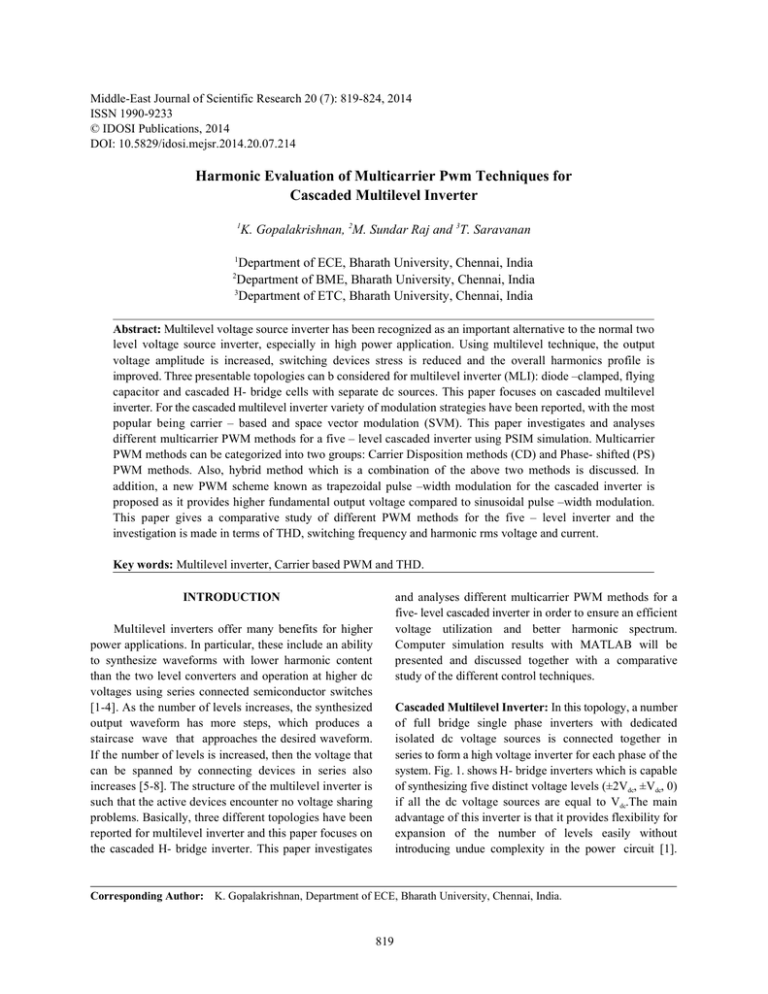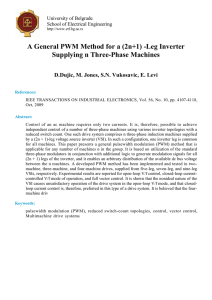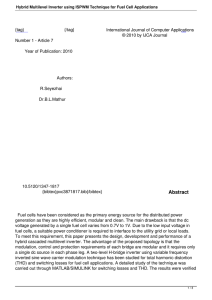c - Idosi
advertisement

Middle-East Journal of Scientific Research 20 (7): 819-824, 2014 ISSN 1990-9233 © IDOSI Publications, 2014 DOI: 10.5829/idosi.mejsr.2014.20.07.214 Harmonic Evaluation of Multicarrier Pwm Techniques for Cascaded Multilevel Inverter 1 K. Gopalakrishnan, 2M. Sundar Raj and 3T. Saravanan Department of ECE, Bharath University, Chennai, India Department of BME, Bharath University, Chennai, India 3 Department of ETC, Bharath University, Chennai, India 1 2 Abstract: Multilevel voltage source inverter has been recognized as an important alternative to the normal two level voltage source inverter, especially in high power application. Using multilevel technique, the output voltage amplitude is increased, switching devices stress is reduced and the overall harmonics profile is improved. Three presentable topologies can b considered for multilevel inverter (MLI): diode –clamped, flying capacitor and cascaded H- bridge cells with separate dc sources. This paper focuses on cascaded multilevel inverter. For the cascaded multilevel inverter variety of modulation strategies have been reported, with the most popular being carrier – based and space vector modulation (SVM). This paper investigates and analyses different multicarrier PWM methods for a five – level cascaded inverter using PSIM simulation. Multicarrier PWM methods can be categorized into two groups: Carrier Disposition methods (CD) and Phase- shifted (PS) PWM methods. Also, hybrid method which is a combination of the above two methods is discussed. In addition, a new PWM scheme known as trapezoidal pulse –width modulation for the cascaded inverter is proposed as it provides higher fundamental output voltage compared to sinusoidal pulse –width modulation. This paper gives a comparative study of different PWM methods for the five – level inverter and the investigation is made in terms of THD, switching frequency and harmonic rms voltage and current. Key words: Multilevel inverter, Carrier based PWM and THD. INTRODUCTION and analyses different multicarrier PWM methods for a five- level cascaded inverter in order to ensure an efficient voltage utilization and better harmonic spectrum. Computer simulation results with MATLAB will be presented and discussed together with a comparative study of the different control techniques. Multilevel inverters offer many benefits for higher power applications. In particular, these include an ability to synthesize waveforms with lower harmonic content than the two level converters and operation at higher dc voltages using series connected semiconductor switches [1-4]. As the number of levels increases, the synthesized output waveform has more steps, which produces a staircase wave that approaches the desired waveform. If the number of levels is increased, then the voltage that can be spanned by connecting devices in series also increases [5-8]. The structure of the multilevel inverter is such that the active devices encounter no voltage sharing problems. Basically, three different topologies have been reported for multilevel inverter and this paper focuses on the cascaded H- bridge inverter. This paper investigates Cascaded Multilevel Inverter: In this topology, a number of full bridge single phase inverters with dedicated isolated dc voltage sources is connected together in series to form a high voltage inverter for each phase of the system. Fig. 1. shows H- bridge inverters which is capable of synthesizing five distinct voltage levels (±2Vdc, ±Vdc, 0) if all the dc voltage sources are equal to Vdc.The main advantage of this inverter is that it provides flexibility for expansion of the number of levels easily without introducing undue complexity in the power circuit [1]. Corresponding Author: K. Gopalakrishnan, Department of ECE, Bharath University, Chennai, India. 819 Middle-East J. Sci. Res., 20 (7): 819-824, 2014 This paper analyses and compares the harmonic characteristics of these methods for the best choice of multilevel inverter operation. Carrier Disposition Methods: Multicarrier PWM techniques entail the natural sampling of a single modulating or reference waveform typically being sinusoidal, through several carrier signals typically being triangular waveforms. Carrier Disposition methods are classified as Alternative Phase Opposition (APOD) technique, Phase Opposition Disposition (POD) technique and Phase Disposition (PD) techniques. In the APOD method, m-1 carrier waveforms are required for a m- level phase waveform which are phase displaced by 180 degrees alternately. The most significant harmonics are centered as sidebands around the carrier frequency. No harmonics occur at the carrier frequency. In the POD method four carrier waves are compared with sine wave. Two carrier waves above the zero reference are in phase and also two carrier waves below the reference are in phase but 180-degree phase shifted from those above zero. Corresponding firing pulse are generated to switches al, b2, cl and d2. (refer Fig. 4). In the PD method four carrier waves are compared with sine wave. Two carrier waves above the zero reference are in phase and also two carrier waves below the reference are in phase. (refer Fig. 3). Fig. 1: A Five – Level Cascaded Inverter [9, 10] Also, extra clamping diodes are not needed. Modularized circuit layout and packaging is possible because each level has the same structure and there are no extra clamping diodes or voltage balancing capacitor. This cascade inverter is suitable for many utility applications as it costs less, have higher performance, less EMI and higher efficiency than the traditional inverter [11-12]. Multicarrier Pwm Techniques: Pulse width modulation is a most important part of power electronic systems and there has been considerable research effort over the years to determine optimum PWM strategies and operating criteria for various applications. Of all the different modulation techniques, this paper focuses on carrier based PWM techniques and their application to a 5- level cascaded inverter. This is because carrier based PWM is easily implemented in analog or digital circuitry or using software techniques shows good performance at moderate switch frequencies and has good dynamic performance, suited for closed loop control. Multicarrier PWM techniques can be categorized as follows: Phase Shifted Method: The phase shifted multicarrier PWM method uses 4 carrier signals of the same amplitude and frequency which are phase shifted by 90 degrees to one another to generate the five level inverter output voltages [3]. The gate signals for the cascaded inverter can be derived directly from the PWM signals (comparison of the carrier with the sinusoidal reference). Hybrid Method: This technique combines the previous dispositions technique and the well-known phase shifted multicarrier PWM technique. Two bands are used for modulation, however, each time the level of the converter is increased, more triangular carriers are introduced and phase shifted accordingly. Carrier Disposition methods, where the reference is sampled through a number of carrier waveforms displaced by contiguous increments of the reference waveform amplitude. Sub- harmonic PWM method with multiple carriers phase shifted accordingly. Hybrid Carrier disposition method incorporating carriers displaced in time, where a reference is sampled through a combination of the aforementioned techniques. Trapezoidal Modulation Method: This scheme uses multiple trapezoid modulating signals with a single triangular carrier. The scheme offers several advantages compared to Sinusoidal PWM (SPWM) in terms of easy and fast real-time waveform generation with higher fundamental output voltage. It uses a single triangular carrier and multiple trapezoid modulating signals. 820 Middle-East J. Sci. Res., 20 (7): 819-824, 2014 Fig. 2: Simulation Circuit for Carrier Disposition Methods Fig. 3: Carrier, reference and switching waveforms for PD method Fig. 4: Carrier and reference waveforms for POD Method 821 Middle-East J. Sci. Res., 20 (7): 819-824, 2014 Fig. 5: Carrier and reference waveforms for Hybrid method Fig. 6: Simulation Circuit for Trapezoidal Modulation Method Fig. 7: Carrier and reference waveforms for Trapezoidal Method The intersection between the trapezoid signals and carrier signal defines the switching instant of the PWM pulse. The number of trapezoidal modulating signals depends on the number of modules (M) of the CMI inverter. For a 5-level CMI inverter, two modules are needed, thus the trapezoidal signals are two. these two trapezoidal signals are compared with single carrier, so two pulses are generated. Cascaded multilevel inverter required four pulse for its operation in order to make it has four pulse ‘C’ code is generated. The Fig. 6. shows that sel_aloc1 generate the gate pulse a1and b2, similarly sel_aloc2 generates gate pulse c1 and d2. Simulation Results and Comparison: The simulation is performed to analyse and compare the harmonic characteristics for the multicarrier PWM techniques from the view point of THD [4]. In this paper, a number of multilcarrier PWM switching techniques are discussed 822 Middle-East J. Sci. Res., 20 (7): 819-824, 2014 Fig. 8: Spectrum for Hybrid and Trapezoidal Modulation Methods Fig. 9: Spectrum for PS and PD Modulation Methods Fig. 10: Comparison of Different Modulation Techniques 823 Middle-East J. Sci. Res., 20 (7): 819-824, 2014 REFERENCES and information is provided in igs.2, 3,4,5,6.However, the simulated output waveforms are presented for one value of the modulation index, that is ma = 0.8.In most applications, output converter power is controlled by varying the amplitude modulation index value. It is therefore important to investigate the quality of the various converter waveforms for all amplitude modulation indices. Fig. 8 shows the harmonic spectrum of different modulation strategy. From the simulation results, it is clear that the PS technique is superior to other techniques within the entire modulation index. The reason is that the switching frequency of the PS technique four times higher than that of the other techniques. Also differences in the spectra of the inverter output voltage waveforms for the above mentioned modulation methods are more pronounced at low mf and dependent on whether mf is even or odd [4]. When comparing the PS/APOD to the POD method, the spectrum for the PS method spreads the harmonic energy more evenly within the sidebands. Fig. 10. compares the THD for the different methods for a five- level cascade inverter. While considering the THD factor, PD favours better among the carrier disposition techniques. The PS is slightly better than the hybrid for a 5- level system. The gap between the fundamental and the first significant harmonics for the PS and hybrid techniques is always improved when increasing the number of levels as the harmonics are moved to higher frequencies [5]. This is not true for the CD PWM techniques. 1. José Rodriguez, 2002. Multilevel Inverters: “A Survey of Topologies, Controls and Applications, IEEE transactions on Industrial Electronics, 49(4): 724-737. 2. Muhammad H. Rashid, Power electronics, PrenticeHall of India, pp: 406-430. 3. Martha Calais, Lawrence J. Borlel Vassilios and G. Agelidis, 2001. Analysis of Multicarrier PWM Methods for a Single-phase Five Level Inverter, IEEE transactions on Power Electronics, pp: 1351-1356. 4. Leon M. Tolbert and Thomas G. Habetler, 1999. Multilevel PWM Methods at Low Modulation Indices, IEEETransactions on Power Electronics. 5. Vassilios, Agelidis and Martina Calais, 1998. Application Specific Harmonic Performance Evaluation of Multicarrier PWM Technique, IEEE-Trans. 7. Vijayaragavan, S.P., B. Karthik, T.V.U. Kiran Kumar and M. Sundar Raj, 2013. Analysis of Chaotic DC-DC Converter Using Wavelet Transform, Middle-East Journal of Scientific Research, ISSN: 1990-9233, 16(12): 1813-181. 8. Vijayaragavan, S.P., B. Karthik, T.V.U. Kiran Kumar and M. Sundar Raj, 2013. Robotic Surveillance For Patient Care In Hospitals, Middle-East Journal of Scientific Research, ISSN: 1990-9233,6(12): 1820-1824. 9. Vijayaragavan, S.P., T.V.U. Kiran Kumar and M. Sundar Raj, 2013. Study of effect of MAI and its reduction in an OCDMA system, Middle-East Journal of Scientific Research, ISSN: 1990-9233, 16(12): 1807-1812. 10. Srinivasan, V. and T. Saravanan, 2013. Analysis of Harmonic at Educational Division Using C.A. 8332, Middle-East Journal of Scientific Research, ISSN: 1990-9233, 16(12): 1768-1773. 11. Srinivasan, V. and T. Saravanan, 2013. Reformation and Market Design of Power Sector, Middle-East Journal of Scientific Research, ISSN: 1990-9233, 16(12): 1763-1767. 12. Srinivasan, V., T. Saravanan and R. Udayakumar, 2013. Specific Absorption Rate In The Cell Phone User’s Head, Middle-East Journal of Scientific Research, ISSN: 1990-9233, 16(12): 1748-1750. CONCLUSION In this paper, the disposition, phase- shifted and trapezoidal modulation techniques have been studied. A hybrid mutlicarrier one is also considered. The THD for the different modulation strategies have been calculated and presented for a five- level cascaded inverter. The PD method is better compared with the APOD and POD ones. The hybrid is not necessarily worse than the PS and this is significant as the hybrid requires half the switching frequency when compared with PS. Therefore, for a 5- level cascaded inverter it is better to employ PS and trapezoidal modulation techniques because of lower THD value. 824






